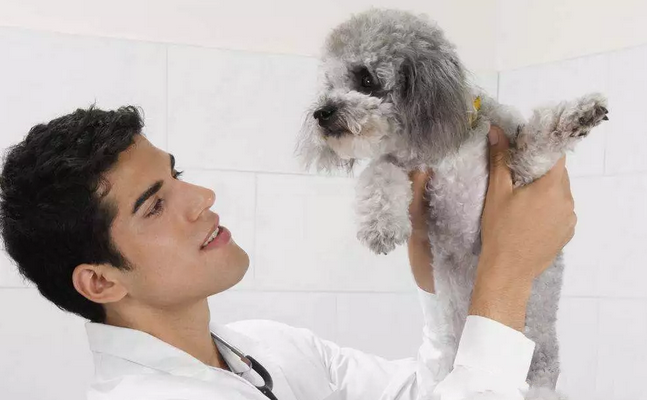A Poodle was taken to a pet hospital by its owner because of a persistent cough. As soon as the doctor opened the dog's mouth, they found that the dog's oral mucosa was already purple, and it needed to open its mouth to breathe smoothly. Doctors diagnosed the dog with symptoms of heart failure and pulmonary edema. When the doctor told the owner of his condition, the owner looked shocked, always thinking that the dog just had a cold, and such a problem would occur.

Small dogs have a high risk of heart disease, but very few owners fully know the symptoms of heart disease . Therefore, some dogs are old and weak, panting, and their abdomens are swollen. After that, the dog suddenly dies, and most owners will think that it is old and dead.
However, heart disease is not a terminal illness. Like people, it can be controlled with drugs and pay attention to the details of daily life. Dogs can accompany us for a few more years.
From cold to heart disease?
Most dogs are diagnosed with heart disease because they cough after exercising or at night nonstop. The owners mistook them for a cold and sent them to the hospital. As a result, it was found that the dog has suffered from heart disease, and the degree is not shallow! In the early stage of the disease, these symptoms are not very obvious, so it is easy to be ignored by the owner.

The invisible killer of small dogs!
According to clinical statistics, purebred Dogs have a higher chance of developing heart disease, possibly because of a genetic defect. But because the data is purely statistical, will it be biased because the owner of the skewer doesn't care at all?
In general, congenital heart disease occurs in young dogs (
As most small dogs get older, the heart's mitral valve degenerates and begins to fail to provide adequately oxygenated blood.
Poodles, Maltese, Chihuahua and Pomeranian small dogs, which are genetically at high risk for heart valve disease ethnic groups.
Heart disease mainly has the following symptoms:
In fact, most of them are chronic heart disease, which dragged on for a long time until the owner discovered that they became Acute heart disease.
How can heart disease be prevented?
The best response to heart disease is early detection and early treatment. The sooner we learn that a dog has heart disease, the sooner we can adjust our dog's habits, improve quality of life, and reduce complications.
To prevent heart disease, it is necessary for dogs to form good living habits.
1. Have enough exercise every day.
2. Eat a healthy diet.
3. Appropriate weight. Some owners keep their dogs so round that they can't touch the ribs at all, not to mention heart disease, high blood pressure and diabetes.
Do not eat too much, plus moderate exercise, is the only way to prevent heart disease.
4. Nutrients necessary to maintain heart health: EPA, DHA, L-arginine, antioxidants, vitamin B complex, magnesium, aminoethanesulfonic acid, L-carnitine.
Don't give your dog heart prescription food in advance to prevent heart disease. , The grade of prescription food is equivalent to drugs, and the wrong place is poison. The heart prescription food is much lower in salt than the general feed. If it is started too early, the salt content in the body is too low, but it will intensify the neurohormonal response that wants to keep more water in the body, thereby causing a greater burden on the heart.
Heart disease is not terrible!
If your dog is unfortunate enough to be diagnosed with heart disease, don't be discouraged. Heart disease in dogs is not a monstrous beast. Similar to humans, as long as they receive careful care and proper treatment, dogs can live like ordinary dogs.
Due to their slenderness, heart disease dogs cannot be exposed to extreme temperatures and should avoid strenuous exercise on a daily basis. Give your dog a less stressful environment to keep your dog from being bothered by noise. In addition to regular health check-ups and follow-up visits, owners can check their dog's health on a daily basis. It is divided into five steps of HEART to help doctors master the changes in the dog's condition, so as to change the dog's treatment plan.
H: hear
Listen for abnormal breathing or coughing, and also record and observe the dog's breathing and heartbeat. (A dog's normal resting breath rate should be between 16 and 30 breaths per minute). If it exceeds 50 breaths per minute, symptoms of heart failure (pulmonary edema) may occur.
E: exam
Take your dog for regular checkups.
A: ask
Ask the veterinarian's professional opinion, keep in touch with the veterinarian, and assist the veterinarian to monitor the dog's condition.
R: relax
Relax, keep the dog's mentality stable, and gradually change its living habits. Relax yourself too, because the owner's negative emotions are likely to be transmitted to the dog. Therefore, the owner should treat the fact that the dog is sick with a normal heart.
T: Treatment
Actively cooperate with the doctor's treatment, and give drug treatment when the dog's condition meets the medication standards, delay the deterioration of the condition, establish a good quality of life or even prolong life, change the dog's condition. Dog Habits Assist Treatment.
Every owner wants to play foolishly with the dog every day and live happily, but the hidden diseases, not understanding does not mean that they do not exist. The aging of dogs is an insurmountable hurdle. If you wait until then to understand, most of the people waiting for their owners will be at a loss and anxious.
Re-emphasize the importance of regular medical checkups. Many diseases do not have obvious manifestations in the early stage, and dogs are likely to miss the best treatment period because of this, making the owner regretful, and regular physical examinations can effectively prevent this from happening. Through pet physical examination, we can also have a further understanding of the dog's physical condition, so as to formulate the most suitable feeding and management plan for it, and give the dog a healthier life.
![[Dog Training 5] The training method of pet dog dining etiquette](/static/img/12192/12192_1.jpg)





